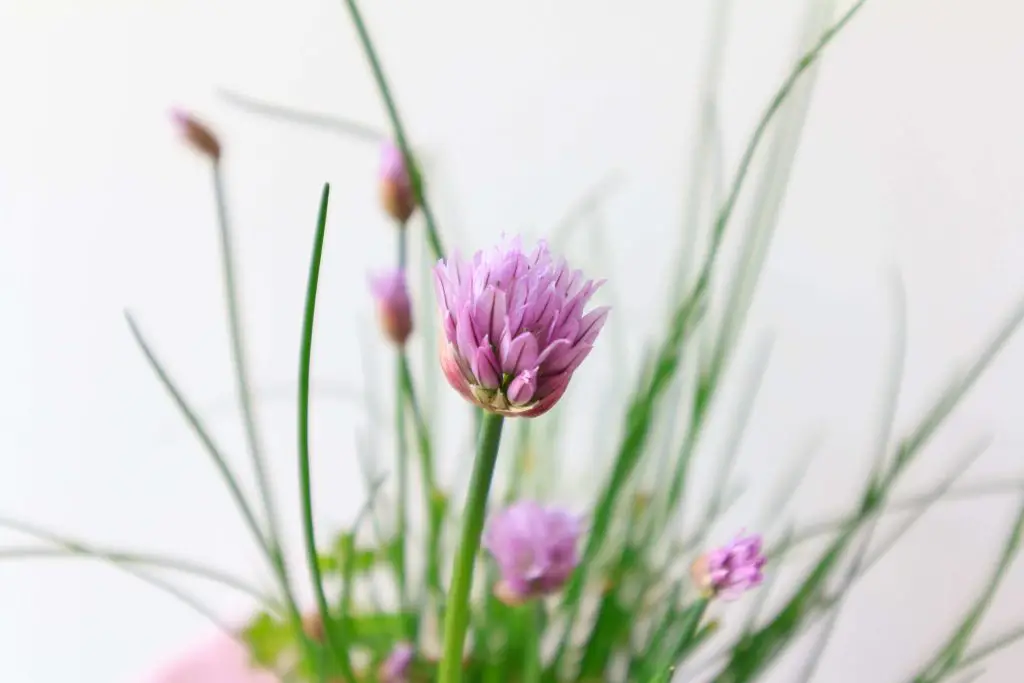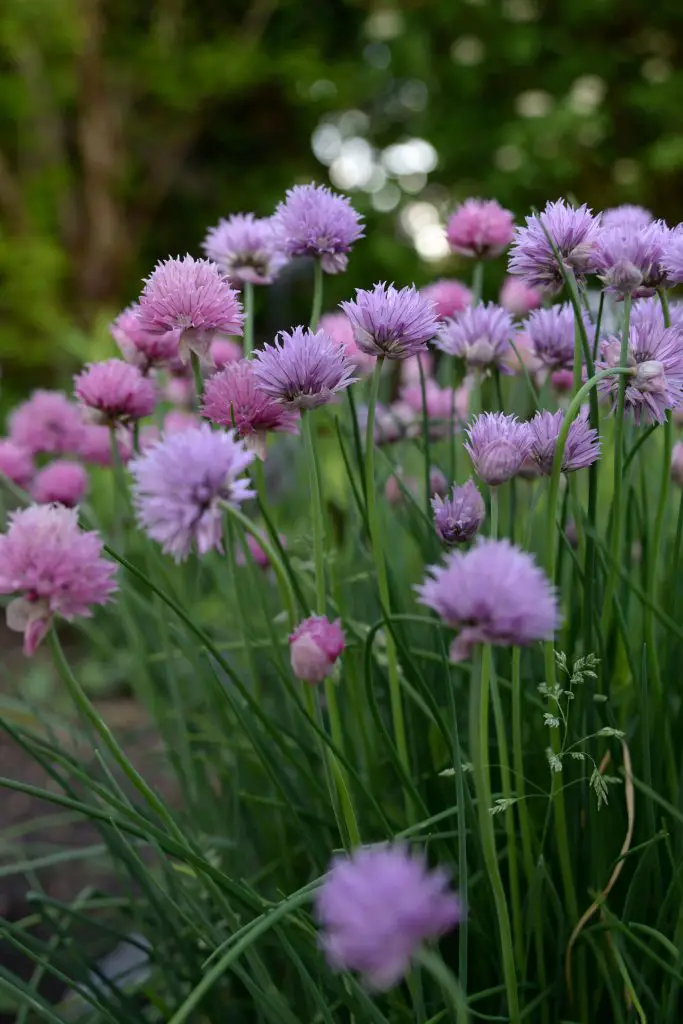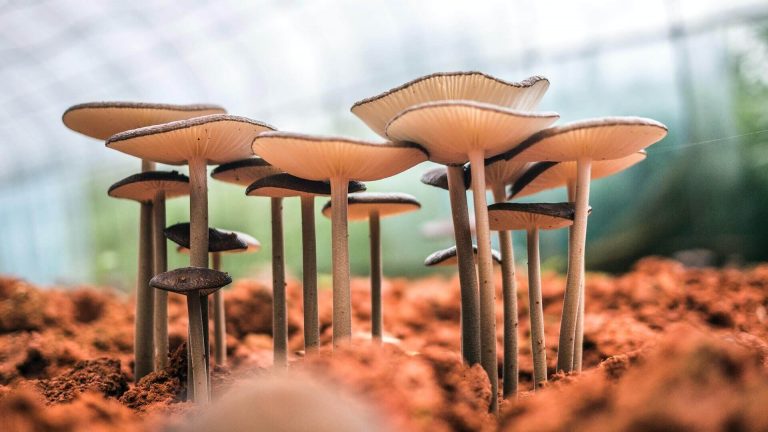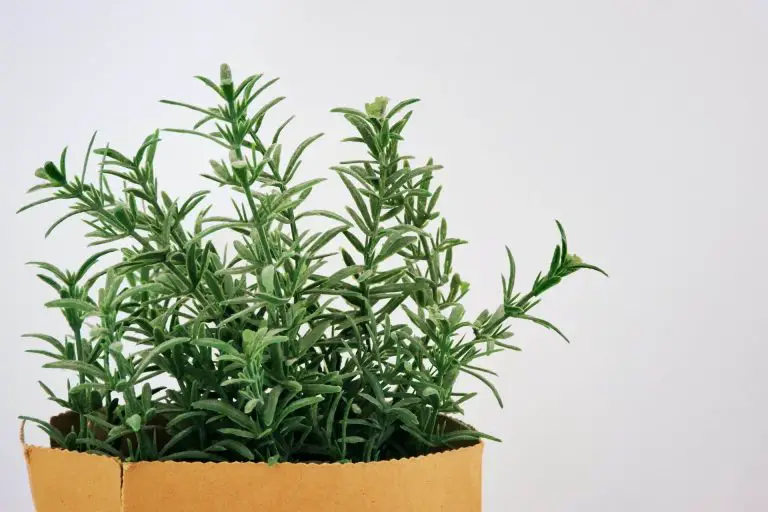How To Harvest Chives Without Killing The Plant [Exact Steps]
Do you want to know how to harvest chives without killing the plant?
Ever made a wrong cut and ended up killing your plant?
Harvesting chives is rewarding in many ways including promoting its growth. That means you can keep having chives over and over. Yay!
Don’t worry! I will help guide you on how to harvest chives without killing the plant, the tools you will need, and how you can create the optimum conditions for your chives to flourish.
Harvesting chives can be tricky at first, but with the right method, practice, and a little patience, you’ll get it in no time!
At A Glance: How To Harvest Chives Without Killing The Plant
Step 1: Inspect your chive plant to determine if your chives are ready to be harvested.
Step 2: Prepare the tools you need to harvest your chives.
Step 3: Pick the perfect time to harvest.
Step 4: Make the right cut without killing the plant.

Affiliate Link Disclosure
Some of the links here are affiliate links, and I may earn if you click on them, AT NO EXTRA cost to you. I hope you find the information here useful! Thanks!
Related Posts
- How to Harvest Romaine Lettuce [2022 Update]
- How To Harvest Broccoli THE RIGHT Way!
- How To Harvest Rosemary [The RIGHT Way!]
- How To Harvest BASIL Seeds- The RIGHT Way!
- How To Harvest Cabbage- The RIGHT Way!
How To Harvest Chives Without Killing The Plant
If you have never done this or do not know how to harvest chives without killing plant, you will be pleasantly surprised at how simple it is.
With a few simple steps and the right tools, anyone can learn how to harvest chives without killing the plant.
Because chives grow in thick clumps, it is advisable to harvest the chives in bunches to ensure that they will grow back at the same length and condition.
So how do you harvest chives without killing the plant?
Here are some step-by-step guides on how to cut chives to encourage growth and harvest your chives like a pro:
Step 1: Inspect Your Chive Plant To Determine If It Is Ready To Be Harvested.
First, you have to identify and assess whether your chives are ready to be harvested. Chives need to be at least seven inches in height for them to be harvested.
Step 2: Prepare The Tools You Need To Harvest Your Chives.
To harvest chives, you need a sharp pair of heavy-duty scissors.
This can either be a pair of kitchen scissors, garden trimmers, or even shears. The important part is that it is sharp as you do not want to use a blunt cutter and damage the chives.
Another important step is to clean your tool before the harvest. This step is very important because when you use an unclean tool to harvest your fresh chives, it may infect the plant with bacteria and might even cause your plant to die.
Whether you choose to use a pair of kitchen scissors or a garden trimmer, cleaning your tool prior to the harvest will prevent the spread of bacteria or fungal diseases.
Step 3: Pick The Perfect Time To Harvest.
This might sound trivial, but choosing the right time of day to harvest chives will affect the quality of your harvest. The best time to harvest chives is early in the morning when the weather is nice and cool.
Harvesting chives on a hot sunny day will cause the plant to have heat stress and affect the quality in terms of freshness and taste.
Step 4: Make The Right Cut Without Killing The Plant.
Now that you have followed all the steps above, you can finally cut and harvest your chives.
You can start by gathering the leaves of the chives with your hands so they will be easier to cut in one go.
You will want to leave at least 5 cm of the leaves still intact from the soil.
You can go ahead and cut the entire chive leaves leaving that little bit of chives intact to allow the chives to continue to grow again.
Chives should be cut from the base and not the tip.
There are times when you only need a small amount and do not need to use the whole bunch. You may be tempted to cut it from the tip of the chives, but doing this may eventually kill the plant.
Also, when you want to harvest chives without killing the plant, it is very important that you avoid tugging or pulling the chives from the ground.
This will loosen the plant and can damage the roots and kill the plant.

What Are Chives?
Chives are a type of herb that produces edible leaves and flowers. It is tubular and slender and can be easily mistaken for grass. However, unlike grass, it has a distinct taste similar to onions, only it is milder in flavor. Chives can grow up to 15 inches in height or more.
The chives plants are perennial plants, which means that their lifespan is longer than two years. Most herbs have annual or biennial lifespans. Chives are herbs that are widely available across Asia, Europe, and North America.
Chives are delicious and can be easily paired with soups, salads, and egg-based dishes. It is also used as a garnish as its taste is not very intense and overwhelming.
When To Harvest Chives
If you grow your chives from the seeds, it needs around 60-80 days before it is ready to be harvested. However, if you transplant your plant from the cuttings or just harvest your chives, you will have to wait around 30 days before you can harvest the plant again.
When your chive plant is planted from the seedling, the first year would yield 3-4 harvests, which is about every 4 months.
After the first year, you can expect to harvest your chive plants every month. However, after about 3-4 years, you will need to divide the chive clumps and replant them to avoid overcrowding and overgrowth.
The easiest indicator to help you know when your chives are ready to be harvested is when it reaches a height of at least 7 inches. When your chives reach this minimum height, it is ready to be harvested.
Tools You Will Need
Chive plants grow quite quickly compared to other plants. Therefore, depending on the condition of your plant, you might need to harvest it more often. Having a set of harvesting tools on standby is always a good idea when you have chives.
1. Garden Trimmer
This is a common item to find in one’s gardening tool kit. The garden trimmer is convenient and has a small tip so that it is easy to maneuver tight spaces and avoid nicking or damaging other stems.
It is also important to keep it clean to avoid the tool from getting rusty and spreading harmful bacteria to the plants.
If you don’t already own one or wish to replace your old rusty trimmer, you can check out my recommendations below.
Gerossi Premium Bypass Pruning Shears
Vivosun 6.5” Gardening Scissors
2. A Pair Of Kitchen Scissors
Alternatively, you can opt to use your trusty kitchen scissors. This is practical if you don’t have many herbs planted and rarely have to harvest your plants. It’s also a good thing because you will probably already have a pair of scissors in your kitchen.
However, the downside to this is you will have to clean your scissors more often in between using them daily and also for harvesting.
Here are my top picks for high-quality kitchen scissors that are also multi-purpose:
Heavy Duty Kitchen Shears by iBayam
All Purpose Shears by KitchenAid
3. Gloves
It’s always a good idea to put on a pair of gardening gloves when dealing with sharp gardening tools.
Whether you’re harvesting from a potted plant or a garden bed, a pair of gloves is practical and important for safety purposes. You do not want to accidentally cut yourself when cutting the stems.
If you are looking for some high-quality gardening gloves, I have included my favorite ones below:
Ladies Gardening Gloves by COOLJOB
2 Pair Garden Gloves Women and Men Set by Amazing Stuff For You!
Leather Gardening Gloves by Bamllum
Harvesting Chive Flowers
Chives are herbs that are edible in their entirety. From the buds to the stalks, to even the flowers. Yes, the flowers are edible too!
Chive flowers are a beautiful shade of lilac and will look wonderful as a garnish. It can be used to brighten up and add a colorful addition to any dish.
Some might wonder, ‘ Should I cut the flower off my chives?’.
This is a great question to ask because eating flowers might not be appealing to everyone.
If you choose not to eat the flowers, you can always place them in a vase and make a bouquet out of them. Not only that, you can harvest the chive flowers to get seeds for future propagation.
Another great question is ‘Can you harvest chives after they flower?
This is an important question because if you want to harvest chives to add to your cooking, you should avoid harvesting chives after the flowers emerge.
The stalks will become thicker to support the weight of the flower. Not only that, but the leaves will also lose their taste and nutrients.
My opinion is, you should always harvest chive flowers whether you intend to eat them or not because they will compromise the taste of your chives.
The way to harvest chive flowers is the same way you would harvest the leaves. You can use a sharp pair of scissors or a garden trimmer and cut it at the base of the plant.
This way, it will ensure and promote the growth of new leaves and flowers so you can continue to harvest them later on.

Benefits Of Harvesting Chives
Harvesting chives will not only provide benefits to the plant itself but can also provide a delicious multi-purpose ingredient to add to your dishes.
Some of the benefits of harvesting chives are:
1. Harvesting chives encourages the plant to grow new leaves and keeps the plant healthy.
2. Harvesting or pruning chives will help maintain their shape and avoids overcrowding and overgrowth.
3. You can eat every part of the chives, including the leaves, flowers, and bulbs.
The Best Conditions To Promote Growth For Chives
There are several factors that will help promote the growth of chive plants and help them thrive and increase their yield.
Here are ways you can promote the growth of your chive plants:
1. Overwatering chive plants will hinder the growth of your chive plants or even kill them. In fact, it is better to underwater your chive than to overwater it.
2. Trim off all the dead and yellowing leaves at the base of the plant. Not doing so will only result in its spreading and affect the health of the entire plant.
3. Chives need at least 6 hours of sunlight for optimal growth. The only time it is sensitive to light is during the germination process.
4. Chives should be pruned or harvested regularly. A matured chive plant can be harvested every month, while a young chive plant should be harvested every 4 months to promote new growth of leaves and maintain overall health.

How To Store Chives
Chives are wonderful herbs that help add flavor and texture to a lot of dishes. It is best to consume chives while it is fresh and within 24 hours of harvesting them. However, that might not always be possible.
Here are the best ways to store chives to preserve their flavor and crispness:
1. Refrigerate fresh chives and they can last up to 72 hours. If you place your chives in a vegetable container, you can keep your chives fresh and crisp for 14 days. Keeping it in a container can help ensure there is moisture in the air, keeping the chives hydrated.
2. Chives can be frozen and used at a later time. This will preserve the taste for months. You can cut up your chive leaves and place them in an ice tray, submerge in water and freeze them.
3. Alternatively, chives can also be dried. It is quite simple to learn how to dry chives. You can do this by placing it in a paper bag, towel, and even in the microwave.
You can choose to either dry them whole or cut them. However, I find that drying them cut will take a shorter time than drying them whole.
If you choose to air dry your chives on a paper bag or towel, it is better to place them in a single layer and spread them out. This is so that the air can circulate freely. When drying, place them in a dry and well-ventilated room, away from direct sunlight.
You can use spread the fresh chives the same way if you choose to microwave them dry. It only takes 30 seconds at medium power to dry chives. It should be repeated until the chives are brittle and dry.
Cool them off for 15 minutes before storing them in an air-tight container.
Although it is important to note that dried chives will lose their flavor within 3-6 months. It will often lose all of its flavors completely after 1 year. Store your dried chive in a dry and dark place.
Things To Avoid When Harvesting Chives
Keeping your chives plant happy is not as hard as one may believe. However, there are things you should avoid when harvesting chives.
Here are the things you should avoid when harvesting your chives:
1. Avoid harvesting your chives before they have attained the minimum height of seven inches. This is because the height is an important indication of whether your plant is ready to be harvested or not.
Harvesting your chives before they are ready could compromise the taste and health of your plant chives.
2. Avoid harvesting until early spring. The best time to make your harvest is when the temperature is nice and cool. Fresh leaves tend to sprout at the beginning of spring.
3. Avoid harvesting in colder months. The cold weather will bring shock to the plants and will cause them to die in freezing and frost weather conditions. The last harvest should be done before fall begins.
4. Avoid harvesting chives when the chive flowers are blooming. This is because the stalk will be woody to support the weight of the flower and compromise the overall taste of the leaves.

FAQs On How To Harvest Chives Without Killing The Plant
How Do You Pick Chives So It Keeps Growing?
So, how do you pick chives so it keeps growing? The correct and easy way to pick chives so it keeps growing is to snip off the whole leaf all the way down to the soil line leaving at least 2-3 inches of the leaves still intact. Your tools should be sharp and clean or it will affect the health of the plant.
Do Chives Keep Growing After You Cut Them?
Do chives keep growing after you cut them? Yes, chives keep growing after you cut them. However, it will grow back the following year only if you make the mistake of cutting the whole plant at once. If you follow the right harvesting technique and care for your plant, you can expect to harvest your chives on a monthly basis.
What To Do With Chives After Harvesting?
Wondering what to do with chives after harvesting? After harvesting chives, you can place the ends in water and store them in the refrigerator for a couple of days. However, it is always best to eat it fresh because chives tend to lose flavor over time. Alternatively, you can freeze chopped chives in freezer bags or even ice trays.
How Many Times Can You Harvest Chives?
You can harvest chives 3 to 4 times during the first year. After that, you can harvest your chive plants on a monthly basis. Chives will continue to regrow if it is harvested with the right technique. Harvest the leaves from the base leaving only 1-2 inches of the leaves still intact.
How To Harvest Basil Without Killing The Plant?
Wondering how to harvest basil without killing the plant? The easy way to harvest basil without killing the plant is to cut ¼ inches above the segment where the leaves come off on the main stem. This is the same method and technique to prune your basil plant and encourage new growth.
How To Harvest Parsley Without Killing The Plant?
How to harvest parsley without killing the plant? Snip off a stem or two or three from the base of the plant. Then you can pick the individual leaves and stems you want to use in your dish or garnish. Cutting the parsleys this way will ensure your plant keeps producing parsleys all season long.
How To Harvest Rosemary Without Killing The Plant?
How to harvest rosemary without killing the plant? Use a sharp pruner to remove stems rather than pulling or tugging on the branches. Remember to avoid cutting your plant not more than ⅓ of the stem. Tugging on the branches and cutting too much of the stem will hinder the plant’s growth and can even kill it.
Chives are not the easiest plants to grow or harvest. They may require extra attention compared to other herbs.
But now that you know how to harvest chives without killing the plant, and their most optimum growing conditions, they are very easy to maintain and the results are worth it because there is nothing quite like cooking with fresh herbs!
Comment below and let me know what your favorite plants are to grow and harvest. And if you have any useful tips, feel free to share. I would love to hear from you and grow our community!
Related Posts
- How To Harvest Parsley Without Killing The Plant -Exact Steps! [2023]
- How To Harvest Sage Without Killing The Plant & What To Avoid! [2023]
- How To Harvest Kale Without Killing The Plant [What to Avoid!] 2023
- How To Harvest Swiss Chard Without Killing The Plant [Exact Steps!]
- How To Harvest Spinach Without Killing The Plant: Exact Steps!
- How To Harvest Dill Without Killing The Plant [Exact Steps]












![How To Grow Moneymaker Tomatoes + Tips To Grow Faster! [2022]](https://aboveandbeyondgardening.com/wp-content/uploads/2022/08/how-to-grow-money-maker-tomatoes-768x512.jpg)
![How To Propagate Orchids [ An Easy 2022 Guide]](https://aboveandbeyondgardening.com/wp-content/uploads/2021/10/How-To-Propagate-Orchids-768x512.jpg)


